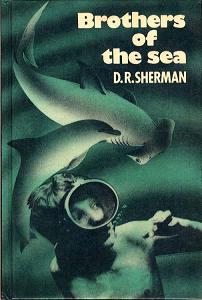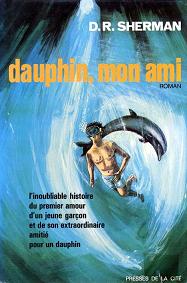Island Conservation-The boy and the dolphin – a fresh look at D.R. Sherman’s tale of a special friendship |03 September 2007

I had first heard of Sherman when I was starting secondary school at the age of thirteen. I was already an inveterate bookworm and an obsessive Seychellophile. So you can imagine my excitement when our English teacher, Gérald Vidot, told us that there was a novel set in Seychelles, Brothers of the Sea by D.R. Sherman, in the Seychelles College library! I remember the intense competition with classmates like Emmanuel d’Offay and Louis Albert to be the first to borrow the book. Emmanuel, far more skilful at negotiating with the librarian, was the first to get to read it. I had to endure several excruciating weeks of waiting before I finally held the battered paperback between my fingers and, with something akin to awe, read sentences like From where he sat he could see the hump-backed shape of Praslin Island lying far across the horizon and They were bananes gabou, long and pale green, and most of the bunches were ripe and ready to be eaten and the others would ripen in a day or two. My daily reality, Seychellois reality, was being described in a novel!
This, of course, is what sets the work of Sherman off from the sugary and often downright mistaken “tourism advertising copy” of many other foreign-born authors writing about Seychelles. After having lived on Praslin for so many years and mixed with Seychellois from all walks of life, he had intimate knowledge of our kreolite, and Brothers of the Sea and his other Seychelles novel, The Boat, are peopled by ordinary Seychellois – with an obvious predilection for fishermen. Let me quote from the blurb of Brothers of the Sea:
“The real beginning of the story occurred fifteen years before the novel opens, when a white baby was left on the doorstep of Roger Mistral, a native fisherman. The baby has been brought up by him as a son, and it is Paul, now a handsome boy, though lame, who has succoured him in the three months since Roger broke his leg. Paul has fished for their food …but even so there has been no money to pay the rent, and the landlord’s overseer is becoming increasingly impatient.
“While they are under the threat of eviction, Paul is attacked when out fishing by a shark and his life is saved, miraculously, by a dolphin. The dolphin becomes his friend, and the story of their friendship, which incidentally attracts the interest of the French landowner’s daughter, Danielle Morel, is beautifully and sensitively described.
“The challenge comes when it is a question of getting money to save his father from 
So Paul has to decide whether to go along with his father’s suggestion that they should kill the marswen, a bottlenose dolphin, and sell the meat. This is why I am talking about a work of fiction in this conservation column. Brothers of the Sea is a “dolphin conservation story” that was first published in 1966, long before the protection of dolphins and other “cetaceans” became a major environmental cause, and thirteen years before Seychelles, backed by France and the United States, successfully spearheaded the drive to turn the Indian Ocean north of 55˚South into a sanctuary for marine mammals (in spite of opposition from the Soviet Union, Japan and South Korea).
“The dolphin turned its head towards him. It regarded him curiously for a moment, and then it blinked once as if in understanding and sank back noiselessly into the water. He saw the dark speeding silhouette of its body below the surface, and he followed its flight out to sea till the shadow of its shape blended invisibly with the darkening colour of the water. It came up once, surfacing in its smooth breathing roll, and then he saw it no more. He turned to the girl, a strange heaviness in his heart. He wished that there had been another fish, just one, so that he could have given it to the dolphin himself.”
Much later, I was to discover that Brothers of the Sea had been translated into other languages: Gefährten des Meeres in German, Hermanos del mar in Spanish, Broeders van de zee in Dutch, Dauphin mon ami in French:
“Le garçon se leva sans un mot. Il entra dans la maison et dans la pièce qu’il partageait avec son père. Il enleva le gros harpon meurtrier de son support sur le mur et ressortit. Il s’arrêta au bas des marches. Il fit face à l’homme, tenant le harpon dans sa main tendue.
- Je ne peux pas le faire, dit-il avec raideur.”
It was not Sherman’s intention, but his novel obviously contributed to drawing attention to Seychelles as an eco-tourism destination. Long before she ever thought of coming to Seychelles to study turtles, one of my colleagues in the Island Conservation Society (ICS), Jeanne Mortimer, read the Reader’s Digest Condensed Book version of Brothers of the Sea. “I was still a teenager in secondary school in the United States, probably about 16 or 17 years old,” she recalls fondly. “I remember reading it in my parents’ bedroom, sitting at a table that received a lot of sunlight...” Some fifteen years later Jeanne found herself observing turtles around the same coral reefs that she had read about in Sherman’s novel.
When I met Sherman on Praslin in March 1985, film director Roman Polanski was there, shooting Pirates. Sherman had a vague plan to contact Polanski to suggest a screenplay for a film version of Brothers of the sea. I don’t think he ever acted on that idea. The film may never become reality, but we have the book to remind us what beautiful and intelligent animals dolphins are, and why we should protect them.
The Island Conservation Society promotes the conservation and restoration of island ecosystems.
by Pat Matyot




